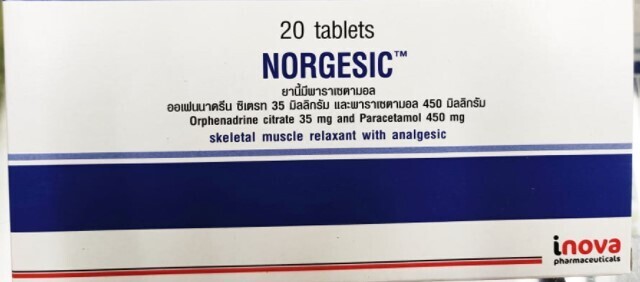Norgesic အကိုက်အခဲနှင့်ကြွက်သားတောင့်တင်းမှုများ သက်သာဆေး
Home/Store/BCX-i Pharmacy ဆေးနှင့်ဆေးပစ္စည်များ/ဆေးအမျိုးအမည်များ Products of Medicine/Antipyretics, analgesics အဖျားကျဆေး နှင့် အကိုက်အခဲပျောက်ဆေးများ
Ks4,150.00
Sold out
Selling by
Sold out
Product Details
အကိုက်အခဲနှင့်ကြွက်သားတောင့်တင်းမှုများအားသက်သာစေပြီး တနေ့၃ကြိမ်ခန့်သို့ဆရာဝန် ညွှန်ကြားချက်အတိုင်းသောက်ရန်
Contents
Orphenadrine citrate, paracetamol.
Description
Orphenadrine citrate 35 mg, paracetamol 450 mg.
Action
Pharmacology: Pharmacodynamics: Orphenadrine citrate is salt form of orphenadrine. It acts in the central nervous system at the brainstem. It has no direct effect of muscle relaxation. In animal it inhibited specifically to reticular formation (substantia reticularis). Orphenadrine does not have myoneural block activity and had no effect on crossed extensor reflex. It is classified as anticholinergic skeletal muscle relaxant. The complete mechanism of effect is unclear. It may involve with analgesic activity and/or muscle relaxation activity for skeletal muscle. Orphenadrine is o-methyl analog of diphenhydramine which is antihistamine without sedative effect. On the contrary, it stimulated central nervous system mildly.
Paracetamol is the active metabolite of phenacetin and acetanilide. The site and mechanism of the analgesic effect is unclear. Paracetamol reduces fever by direct action on the hypothalamic heat-regulating center, which increases dissipation of body heat (via vasodilation and sweating). The action of endogenous pyrogen on heat-regulating center is inhibited. Paracetamol is almost as potent as aspirin in inhibiting prostaglandin synthetase in the CNS, but peripheral inhibition of prostaglandin synthesis is minimal, which may account for its lack of clinical significant antirheumatic and anti-inflammatory effects. Generally, antipyretic and analgesic effects of paracetamol and aspirin are comparable. Aspirin is clearly superior to paracetamol for relief of pain of inflammatory origin. Paracetamol does not inhibit platelet aggregation, affect prothrombin response, produce GI irritation.
Pharmacokinetics: Orphenadrine is absorbed from the gastrointestinal tract and is almost completely metabolized to at least eight metabolites. Orphenadrine and its metabolites are excreted from the body in the urine, with a half-life of 14 hours.
Paracetamol absorption is rapid and almost complete from the GI tract. Peak plasma concentrations occur within 0.5 to 2 hours, with slightly faster absorption from liquid preparations.
Paracetamol is the active metabolite of phenacetin and acetanilide. The site and mechanism of the analgesic effect is unclear. Paracetamol reduces fever by direct action on the hypothalamic heat-regulating center, which increases dissipation of body heat (via vasodilation and sweating). The action of endogenous pyrogen on heat-regulating center is inhibited. Paracetamol is almost as potent as aspirin in inhibiting prostaglandin synthetase in the CNS, but peripheral inhibition of prostaglandin synthesis is minimal, which may account for its lack of clinical significant antirheumatic and anti-inflammatory effects. Generally, antipyretic and analgesic effects of paracetamol and aspirin are comparable. Aspirin is clearly superior to paracetamol for relief of pain of inflammatory origin. Paracetamol does not inhibit platelet aggregation, affect prothrombin response, produce GI irritation.
Pharmacokinetics: Orphenadrine is absorbed from the gastrointestinal tract and is almost completely metabolized to at least eight metabolites. Orphenadrine and its metabolites are excreted from the body in the urine, with a half-life of 14 hours.
Paracetamol absorption is rapid and almost complete from the GI tract. Peak plasma concentrations occur within 0.5 to 2 hours, with slightly faster absorption from liquid preparations.
Indications/Uses
Tension headache, occipital headaches associated with spasm of skeletal muscles in the region of the head and neck. Acute and traumatic conditions of the limbs and trunk: strains, sprains, whiplash injuries, acute torticollis, prolapsed intervertebral disc.
Dosage/Direction for Use
Two tablets three times daily, or as directed by physicians.
Overdosage
Maximum dose of Orphenadrine should not exceed 400 mg per day. Toxic effect which can be caused are excitement, confusion, delirium leading to coma. Convulsions and tachycardia with dilated pupils, and urinary tract retention may occur. Paracetamol dose should not exceed 4 grams per day. A toxic dose can result in liver damage but symptoms may not appear for up to several days after ingestion.
Contraindications
Because of the mild anticholinergic effect of orphenadrine, Norgesic should not be used in patients with glaucoma, myasthenia gravis, pyloric or duodenal obstruction, achalasia, prostatic hypertrophy or obstructions at the bladder neck.
Warnings
Not applicable.
Norgesic အကိုက်အခဲနှင့်ကြွက်သားတောင့်တင်းမှုများ သက်သာဆေး
Display prices in:MMK
